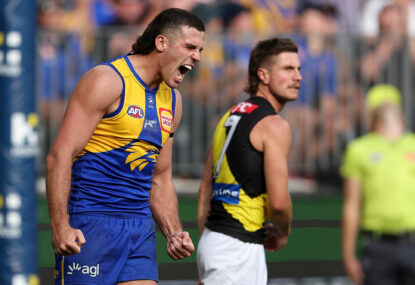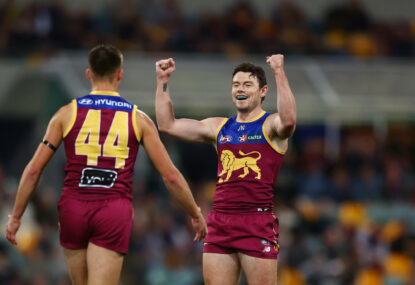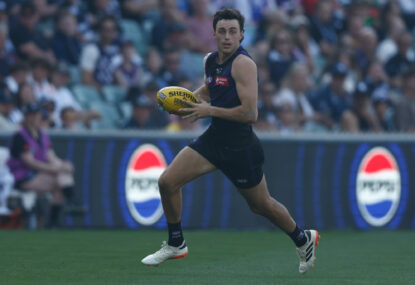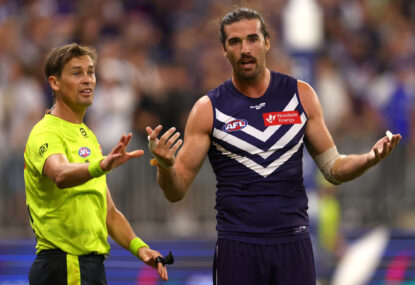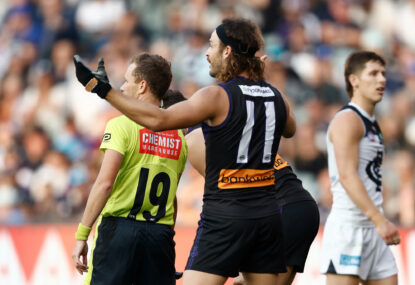My Dad hates the Dockers. He thinks that their clogging up of the game and the focus on low scores is a poor excuse for what footy should be about.
But I am fascinated by them. My first good look at the Ross Lyon Dockers – a full two years after the fact – was the 2013 finals series. Their win over the revived Geelong of that year was a magnificent triumph of focus and ruckwork.
The Fremantle versus Sydney preliminary final will not be remembered as one of the great ones, particularly given the seismic Hawthorn-Geelong curse-buster the night before. But I’m not sure I’ve ever seen anything like what happened in the second quarter.
For a while I’ve suspected that for all the strategies, the winner of most ball sports is simply the team that is able to consistently get more players to the loose ball than the other team. Then the possession, run and chances on goal happen accordingly.
The second quarter featured this to the extreme. Fremantle had blown a dominant first quarter with 2.9 on the scoreboard. In the second Fremantle packed their front half of the field with all 18 of their players. Each loose ball or Swans player with possession attracted about four Dockers swarming towards it, for the whole quarter.
Imagine trying to do anything with three or four guys all around you – it’s impossible. The Swans were smothered. They did not register an inside 50 until the last minute of the quarter.
Fremantle kept their three defenders in a line and pushed up to the halfway line, like a soccer defence, and when the ball spilled to them they would kick it across that line to spread play and get started again.
With the Purple Haze crowd baying for blood, this was more an event to be witnessed than described. It was breathtaking and I couldn’t take my eyes off it. A journo jokingly described it a day later as ‘going back to Little League football’, where everyone just runs towards the ball, with no positions.
The slight downfall was that with everyone pushed into the one front half of the field, the attacking isn’t so clean because there’s no space to be fancy. This was a criticism faced by the legendary Spanish soccer team recently too. With everyone constantly pressed forward or defending on the opposite team, there was no room for flowing attacks.
Nonetheless the suffocation by ‘The System’ eventually created five goals for Freo. At half-time, 7.11 to 2.2, the game had been put away.
Such pressure, I suspect, requires tremendous fitness, mental concentration, and adrenaline. It wasn’t sustainable over a complete three-hour match. Freo eased off after half-time and they and Sydney broke even the rest of the game.
Fremantle had made the 2013 grand final with key position players Matthew Pavlich and Aaron Sandilands missing for long stretches of that season. Thanks to Fremantle’s discipline and the swarming, numbers style of their play, their absences had been covered, much like a Lyon-coached, Nick Riewoldt-less Saints had pushed on in 2010.
I occasionally noticed Freo try to implement The System the next week in the grand final but they didn’t pull it off. The MCG was too big and they were too nervous. Hawthorn were disrupted but clearly had more moments of poise than the Dockers.
Fifty-one weeks after that preliminary final the Purple Haze crowd got together to watch Fremantle versus Port Adelaide at the same Patersons Stadium. Nat Fyfe, who had been just one of the worker ants in 2013, was now receiving the love come the 2014 Finals Series, crowned that season’s AFLPA MVP the week before. He scored two goals in the first quarter against Port.
They were fascinating opponents. Freo’s rise was almost exactly mirrored by Port Adelaide one year after, each on the smarts of a genius new coach. Both clubs had gone from nowhere to seventh and an unexpected finals win in Melbourne, and a year later to a business end showdown with the Hawks, exactly one year apart from each other.
Port, however, had done it in a different way, the opposite way to Freo: by moving the ball and setting players free. It was glorious to watch. But in the second quarter of their 2014 semi-final in Perth it was identically blunted in the way Sydney had been the year before.
A minute before half-time, Freo were up 6.11 to 2.5, almost identically to the year before. Almost everything had happened identically to the 2013 Sydney preliminary final. Fremantle’s style was working again. The commentators wondered if Freo hadn’t put it on the board, but their dominance had been so total that it seemingly didn’t matter.
But it did matter. Chad Wingard snared a goal with one of Port’s very few trips forward right before the siren and after half-time Port’s free-flowing, goal-scoring play unexpectedly blew away Freo’s patented system. Freo’s Purple Haze pressure had been unsustainable.
Now we’re in 2015 with Fremantle so far the only team that can be relied on. ‘The System’ has covered supposedly key player Ryan Crowley being rubbed out. Their matches this year have followed the same template as those two finals: overwhelming first halves followed by the opposition catching up some in the second.
It happened most dramatically against Sydney, in which a 49-point half-time lead was whittled down to three, but the pattern remained in matches against West Coast and last week against Essendon.
Maybe it’s human nature to relax when we’re ahead. Or maybe it’s a bug in The System.





























































































